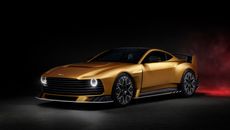Aston Martin DB12 is the latest and greatest in a 75-year lineage of sporting GTs
Billed as the brand’s first ‘Super Tourer’, the V8-powered Aston Martin DB12 marks a new high point in marque’s signature mix of beauty, brawn and sophistication

Aston Martin DB12
The new Aston Martin DB12 blends clever technology and exacting craftsmanship with brutish design inspiration from the earlier DBS, along with an all-new interior and a steady-eyed focus on the future of the brand. It’s an evocative continuation of the ‘DB’ line that started all the way back in 1948 with the 2-Litre Sports model, the original ‘DB1’. Over the past 75 years, we’ve seen the company run all the way through DB2 to DB11, with the notable omission of a ‘DB8’ (it was deemed to be a confusing name for a V12-powered car).

Leaving aside the awkward fact that the DB12 is a V8-powered car, Aston Martin is happily ploughing on with its famous naming tradition (presumably kicking the awkward thought of an unlucky DB13 down the road for a few more years). Superficially, what we have here is a substantial upgrade and overhaul of the DB11, introduced in 2016. Aston Martin describes the DB12 as the ‘world’s first Super Tourer’, slicing and dicing the niches at the upper end of the car market still further to suit its current agenda and target audience.
Up close with the Aston Martin DB12

The first thing to get out of the way is that this car has nothing to do with electrification whatsoever. Although Aston heralds the DB12 as ‘the first of its next-generation sportscars’, there’s not yet any talk of hybridisation, let alone electrification. Aston Martin’s first production PHEV will be the limited-edition Valhalla, a date for which hasn’t yet been announced. In comparison, DB12 is old-school muscle, albeit with a rich veneer of new technology. The latter is evident in the all-new interior, a game-changing development that pushes DB12 straight to the top of its class.

The interior was always DB11’s Achilles’ heel, an overbearing cascade of switches, dials, displays and outdated interfaces that was, at best, a mild inconvenience that couldn’t quite obscure the essential brilliance of actual driving. Luxury has moved on since then, and even the mildest of inconveniences are no longer tolerated. Hence Aston has made a big investment in a new interiors approach, combining digital and analogue with an all-new bespoke infotainment system and an altogether less oppressive feeling.

You still sit low and cossetted within the cabin in a sporting driving position that precludes any sight of the end of the long bonnet as it falls away to the signature metal-vaned Aston Martin grille and (Peter Saville-designed) wings logo. Aston Martins aren’t shrinking, and the DB12 adds a few millimetres in every direction on to the already sizeable DB11, so it’s lucky that the steering is so direct and precise, allowing you to place the car on the road with ease.

The sprightliness comes courtesy of refined and enhanced suspension, with fully adaptive dampers (soft for cruising, firmer for twistier routes), and an uprated 4.0 twin-turbo V8 that puts out 680 PS. That’s theoretically enough for a 202mph top speed, an academic stat that maintains parity with rivals like Ferrari and McLaren, and a 0-6mph sprint in 3.5 seconds.

Such comparisons are all the more potent in 2023 given Aston Martin’s ongoing success in Formula 1 (following a rocky start in 2021). Not only does the sport give the manufacturer a regular chance to trounce its long-running rival Ferrari, F1 also pushes the Aston brand into new markets. It’s an expensive but valuable marketing strategy that is boosted by the company’s very real motorsport origins.
Wallpaper* Newsletter
Receive our daily digest of inspiration, escapism and design stories from around the world direct to your inbox.

A ‘Super Tourer’ must be more than just a sprinter, however. To justify this designation, the DB12 needs to have a broad suite of talents. For marketing folk, this means hunting down empty sectors in the Venn diagram of automotive luxury, not as hardcore as Ferrari, nor as luxurious as Rolls-Royce, not as traditional as a Bentley, more tasteful than a Lamborghini, yet somewhere close enough to every benchmark to deserve its own slot.

None of this would matter is the DB12 was not beautiful. In our opinion, it’s the best-looking Aston Martin since the DB9, a fluid composition that maintains the proportional perfection of its predecessor with tighter detailing and an overall muscularity that evokes the 70s-era Vantage. ‘DB12’s styling, features an all-new front-end treatment, wider stance and more muscular surfaces for increased presence,’ explains Marek Reichman, Aston Martin’s executive vice president and chief creative officer. ‘The interior has also been completely redesigned,’ he adds, ‘with clean horizontal lines that emphasise the sense of space and provide the perfect contemporary backdrop for new a new state-of-the-art infotainment system.’

These digital details matter more and more. Alongside the crisp typography and simple graphics on the screens, there is a companion Aston Martin App, which communicates directly via the car’s on-board e-SIM. The latter also allows OTA updates of the DB12’s software, with additional services due to be added over time. A subscription service provides expanded functionality, including vehicle management and diagnostics, remote lock and unlock and theft alert.

The optional surround sound upgrade marks Aston Martin’s first partnership with British audio specialists Bowers & Wilkins. The 1,170W system uses 15 speakers for immersive 3D sound, with components embedded within the car’s structure for better acoustic performance. The infotainment system also supports wireless Apple CarPlay and Android Auto, while oft-used functions like heating and ventilation are operated by physical controls.

Another first is the inclusion of a ‘Wet’ driving mode in the DB12’s Electronic Stability Programme (ESP) system, selected via the knurled rotary controller in the new centre console. There’s a lot of power to play with, and while the ESP can be overridden if desired, the on-board systems do an excellent job at keeping things in check if you run out of road or ability. There’s also more urgency and vitality than even the fastest DB11, with a propulsive shove accompanied by that howling V8. If this noise is not to your liking, you probably have no place behind the wheel of such a car; at least, that’s what Aston is reasoning right now. Despite the thick-rimmed wheel, the steering is precise and direct, making this a hugely involving car to drive when desired; for everyday driving, it is as docile and refined as a limousine.

So is the DB12’s Super Tourer designation justified? The romance of the road trip is changing fast, as is the cultural acceptance of driving fast. The DB12 is a celebration of a new era, yet it looks forward while keeping one oily foot in the past. For traditionalists, it’s a car without any conceivable downsides, meaning that current customers and Aston fans can and should rush to sign up. But where does that leave electrification? We’re now at a point in time where a hybridised supercar no longer feels heretical, so could there ever be a PHEV or EV in the DB’s future? Perhaps a designation of tomorrow’s ultimate touring machine would be more convincing if there was.
Aston Martin DB12, from £185,000, AstonMartin.com
Jonathan Bell has written for Wallpaper* magazine since 1999, covering everything from architecture and transport design to books, tech and graphic design. He is now the magazine’s Transport and Technology Editor. Jonathan has written and edited 15 books, including Concept Car Design, 21st Century House, and The New Modern House. He is also the host of Wallpaper’s first podcast.
-
 Three new coffee makers for a contemporary brew, from a casual cup to a full-on branded espresso
Three new coffee makers for a contemporary brew, from a casual cup to a full-on branded espressoThree new coffee makers, from AeroPress, Jura and Porsche x La Marzocco, range from the defiantly manual to the bells and whistles of a traditional countertop espresso machine
By Jonathan Bell Published
-
 Don't miss Luxembourg's retro-futuristic lab pavilion in Venice
Don't miss Luxembourg's retro-futuristic lab pavilion in VeniceAs the Venice Biennale enters its last few weeks, catch 'A Comparative Dialogue Act' at the Luxembourg Pavilion
By Amah-Rose Abrams Published
-
 A Berlin park atop an office building offers a new model of urban landscaping
A Berlin park atop an office building offers a new model of urban landscapingA Berlin park and office space by Grüntuch Ernst Architeken offer a symbiotic relationship between urban design and green living materials
By Michael Webb Published
-
 The Ferrari 12Cilindri is the ultimate expression of the marque’s greatest engine
The Ferrari 12Cilindri is the ultimate expression of the marque’s greatest engineWe sample Ferrari's latest, the mighty front-engined grand tourer that bears a simple descriptive name, 12Cilindri
By Rory FH Smith Published
-
 The Ferrari F80 continues the company's tradition of using supercars to showcase tech
The Ferrari F80 continues the company's tradition of using supercars to showcase techJust 799 examples of Ferrari’s ferociously complex and high-tech styled F80 will be made, helping give shape to the sports cars of tomorrow
By Jonathan Bell Published
-
 Aston Martin bring the Midas touch to their super tourer with the DB12 Goldfinger Edition
Aston Martin bring the Midas touch to their super tourer with the DB12 Goldfinger EditionReleased in honour of the sixtieth anniversary of the iconic James Bond film, Aston Martin has gone all out to the DB12 Goldfinger Edition a worthy collector’s item for high rolling film fans
By Jonathan Bell Published
-
 The new V12-powered Aston Martin Vanquish arrives to conquer the world of luxury GT cars
The new V12-powered Aston Martin Vanquish arrives to conquer the world of luxury GT carsThe luxury British marque’s new Vanquish flagship is absolutely, positively, definitely, its final flirtation with V12 power. Or is it?
By Jonathan Bell Published
-
 A 90s icon of Italian sports car design is reborn as the Veloce12 by Touring Superleggera
A 90s icon of Italian sports car design is reborn as the Veloce12 by Touring SuperleggeraCarrozzeria Touring Superleggera have transformed the Ferrari 550 Maranello into an all-analogue, carbon-bodied GT for the modern era
By Jonathan Bell Published
-
 Could a car be any more muscular? Aston Martin unleashes the bold and brutalist Valiant
Could a car be any more muscular? Aston Martin unleashes the bold and brutalist ValiantEquipped with a V12 engine, manual gearbox and chiselled bodywork, the limited-edition Aston Martin Valiant is the company’s most extreme front-engined road car to date
By Jonathan Bell Published
-
 Meet two new Maserati MC20 supercars, the Leggenda and the Icona
Meet two new Maserati MC20 supercars, the Leggenda and the IconaThese Maserati MC20 special editions honour the company’s racing heritage and the 20th anniversary of the Maserati MC12 hypercar
By Jonathan Bell Published
-
 Aston Martin Vantage review: we take the wheel to find out if it makes the supercar grade
Aston Martin Vantage review: we take the wheel to find out if it makes the supercar gradeThe new Aston Martin Vantage is an upgrade on every conceivable metric, resulting in a machine with more power, luxury and dynamic ability than ever before
By Jonathan Bell Published